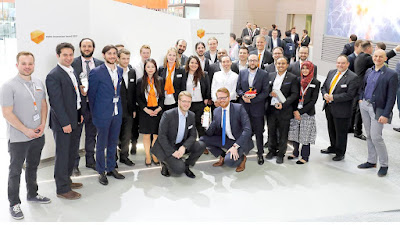My group at the University of Southern California fielded a team in KUKA Innovation Award 2017 competition. Team members included Ariyan Kabir, Sarah Al-Hussaini, Abdullah Alsharhan, Vivek Annem, Iain Brookshaw, Qi Deng, Alec Kanyuck, Nithyananda Kumbla, Joshua Langsfeld, Rishi Malhan, Fadel Muci, Brual Shah, and Shantanu Thakar.
After two preliminary rounds, our team was selected as one of the five finalists. Applicants for this award were expected to demonstrate an innovative robotic application using Kuka iiwa arms. Our team traveled to Hannover Messe in Germany to showcase our entry in the competition. This is one of the largest trade fair in the world. Usually, more than 250,000 visitors attend this trade fair. Distinguished visitors this year included Angela Merkel, Chancellor of Germany.
The focus of our application was automation of finishing processes such as grinding, sanding, and polishing. We combined planning, control, perception, learning, and augmented reality technologies to create a new robotic system for finishing operations. Our setup used two robots. The first robot held the part and the second robot manipulated the cleaning tool. We used external sensors to monitor the task progress.
Our application was significantly different from the traditional robotic applications in manufacturing. Robots in traditional manufacturing operations use pre-programmed motions to carry out the tasks. This idea only works when a robot is used is mass production application to make the same part over and over and this approach does not help in low volume production. An example of this is post-processing operations in additive manufacturing of custom parts. For metal based 3D printing, surface finishing operations are still manual and can take a very long time.
Manual surface finishing tasks are very tedious and time consuming and contribute significantly to the total cost in manufacturing. They also pose risks to the health of the workers. Our team believed that robots should do the tedious labor and humans should perform high level decision making in surface finishing operations. This way, we can increase the productivity of human operators and improve their quality of life.
The automated finishing system needed to manage the interaction between robots, tools, and the part to be finished. Robots needed to learn and optimize parameters on-the-fly for any given object and plan their moves. A perception system was also required for detection and localization, assessing surface quality, and ensuring safety. To achieve these goals, we integrated new planning and learning algorithms with the existing technology for perception and control.
Overall we received a lot of positive feedback on our demonstration. Many companies were interested in deploying our technology. Our team returned back to USC with a resolve to mature the technology and get it ready for deployment.
After two preliminary rounds, our team was selected as one of the five finalists. Applicants for this award were expected to demonstrate an innovative robotic application using Kuka iiwa arms. Our team traveled to Hannover Messe in Germany to showcase our entry in the competition. This is one of the largest trade fair in the world. Usually, more than 250,000 visitors attend this trade fair. Distinguished visitors this year included Angela Merkel, Chancellor of Germany.
The focus of our application was automation of finishing processes such as grinding, sanding, and polishing. We combined planning, control, perception, learning, and augmented reality technologies to create a new robotic system for finishing operations. Our setup used two robots. The first robot held the part and the second robot manipulated the cleaning tool. We used external sensors to monitor the task progress.
Our application was significantly different from the traditional robotic applications in manufacturing. Robots in traditional manufacturing operations use pre-programmed motions to carry out the tasks. This idea only works when a robot is used is mass production application to make the same part over and over and this approach does not help in low volume production. An example of this is post-processing operations in additive manufacturing of custom parts. For metal based 3D printing, surface finishing operations are still manual and can take a very long time.
 |
| Angela Merkel, Chancellor of Germany walked past our booth (Image Source: Kuka) |
 |
| Visitors at our Booth (Image Source: USC CAM) |
 |
| Our Booth at Hannover Messe (Image Source: Kuka) |
 |
| Picture at Awards Ceremony (Image Source: Kuka) |
| Our team with the Finalist Trophy (Image Source: USC CAM) |
Manual surface finishing tasks are very tedious and time consuming and contribute significantly to the total cost in manufacturing. They also pose risks to the health of the workers. Our team believed that robots should do the tedious labor and humans should perform high level decision making in surface finishing operations. This way, we can increase the productivity of human operators and improve their quality of life.
The automated finishing system needed to manage the interaction between robots, tools, and the part to be finished. Robots needed to learn and optimize parameters on-the-fly for any given object and plan their moves. A perception system was also required for detection and localization, assessing surface quality, and ensuring safety. To achieve these goals, we integrated new planning and learning algorithms with the existing technology for perception and control.
Overall we received a lot of positive feedback on our demonstration. Many companies were interested in deploying our technology. Our team returned back to USC with a resolve to mature the technology and get it ready for deployment.